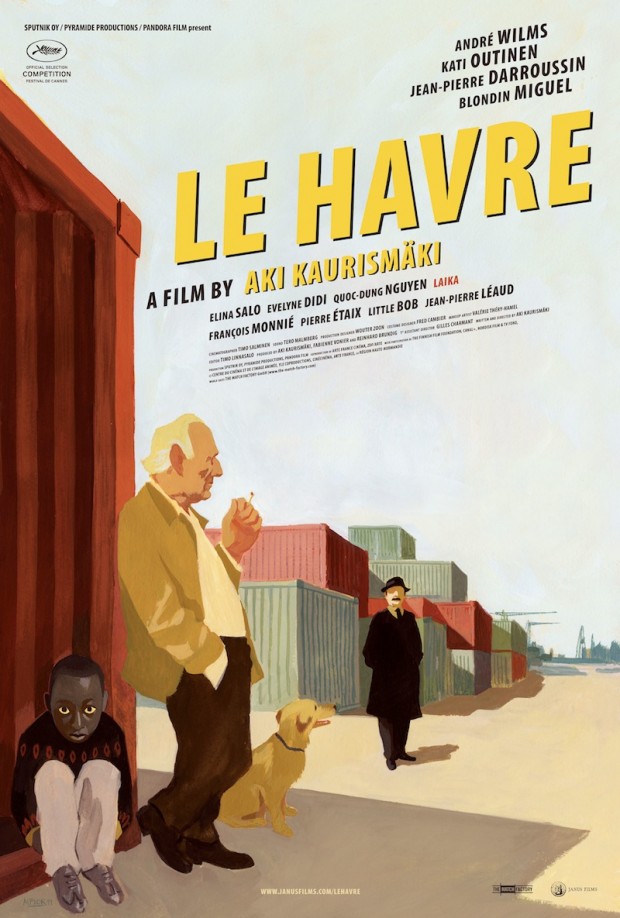An iconographic and text archive related to communication, technology and art.
☛ Janus Films: Le Havre by Aki Kaurismakï, France/Finland, 2011 (official Press Kit: PDF). Official one-sheet poster for the American release of the film, designed and illustrated by Italian artist Manuele Fior. See a larger version (1944 x 2880).
The poster is available for sell over at The Criterion Collection. For more information about it see Manuele Fior’s blog as well as Adrian Curry over at MUBI.com: “Movie Poster of the Week: “Le Havre”” (October 7, 2011). Manuele Fior also created a series of portraits to go along Criterion’s Blu-ray and DVD editions of the film: see Le Havre portraits (Criterion, August 2, 2012). Below is the official U.S. release trailer uploaded on YouTube by Janus Films.
For more about Le Havre see the following links (I especially the answer Kaurismakï gave when Filmmaker Magazine asked why he was still working with 35 mm film):
-
The always exhaustive link roundup produced by David Hudson over at MUBI.com: “Cannes 2011. Aki Kaurismäki’s “Le Havre””, May 17, 2011.
-
Filmmaker Magazine: “Aki Kaurismakï, “Le Havre”” interview by Damon Smith, October 19, 2011.
Filmmaker: Juha was a silent black-and-white film harkening back to the days of early cinema, and I Hired a Contract Killer nodded to the heyday of noir. Le Havre is chock-a-block with references to Melville and Clouzot, especially via the character played by Jean-Pierre Darroussin. Beyond homage, are these references perhaps a deeper means of connecting cinema past and present, at least when the story demands it?
Kaurismäki: I certainly hope so. My “style” —if it exists— is certainly more near Tati than Melville, but I wanted at least to have one character of both plus some Clouzot, Carné, Renoir etc., with a touch of French postwar neorealism plus this and that but just to have these references and tiny homages there, not really to be noticed. The director, however, whom I think more and more [about] nowadays is Charles Chaplin. […]
Filmmaker:
Could you give me a better sense of why working in 35mm and what you’ve called “deep screen space” is an absolute for you, and why even toying with new digital technologies holds no appeal?
Kaurismäki: I´m old enough to die with my boots on.
-
Reverse Shot: “Le Havre. Paint the Town” by Julien Allen, Issue 32.
Le Havre may well be, like the majority of film-nut Kaurismäki’s work, a comically deadpan treatment of a particular type of cinema (having previously essayed road movies, rockumentaries, and film noir, this time he takes on the golden age of French cinema), but there is nothing glib or flippant about his formal decision-making. This is particularly the case in Le Havre when it comes to color. The protagonist, Marcel, played by André Wilms, is framed in the center of the first shot, wearing a camel-colored suede jacket, a working man’s item—in this case, the uniform of a shoe-shine man. This coat, which as the night draws in takes on a burnished quality like wet sand at sunset, is but the most resonant and satisfyingly symbolic shade in a film whose color compositions are, from beginning to end, consistently disarming.
-
The Criterion Collection: “Le Havre: “Always Be a Human”” by Michael Sicinski, July 31, 2012.
Kaurismäki’s Le Havre is a community, one in which people don’t think twice about helping an immigrant (just as the best of them would have hidden a Jew from the Vichy government years before). And in the coda, both a woman and nature itself are reborn. Sappy? I don’t know. Perhaps instead we should call it “counterfactual utopianism.” Kaurismäki uses cinema to envision a world in which the love of humanity overcomes borders, even the one between life and death. His film demonstrates the necessary humanist dialectic—that opening to the other, being changed, means becoming the other, shifting who our family, the very “we,” is. A guarded boundary is a death sentence—the barricade of a self that is destined to wither.
- By Philippe Theophanidis
- on
- ― Published in Art, Communication, Illustration, Movies
- Tagged: Aki Kaurismakï, color, community, design, film, humanism, poster, utopia

